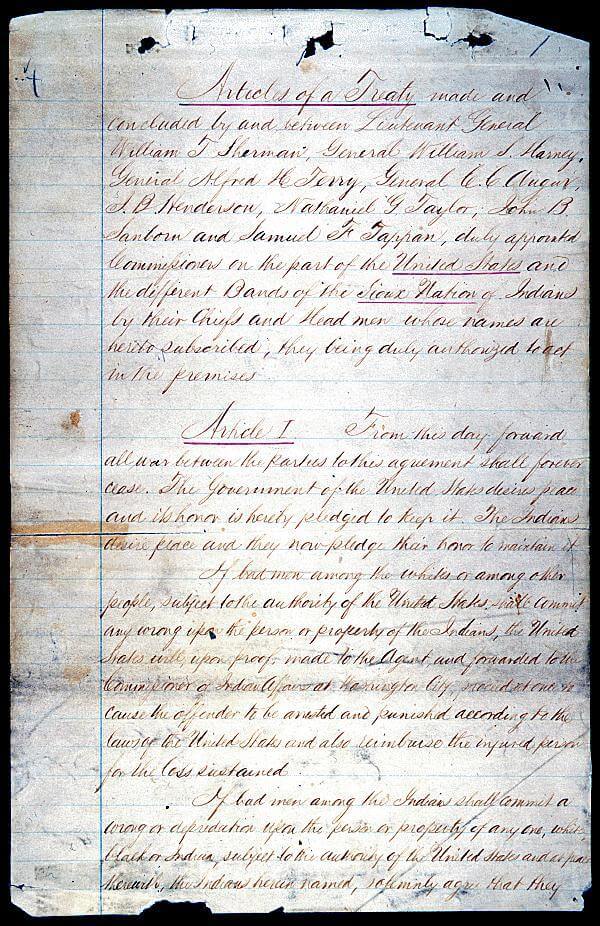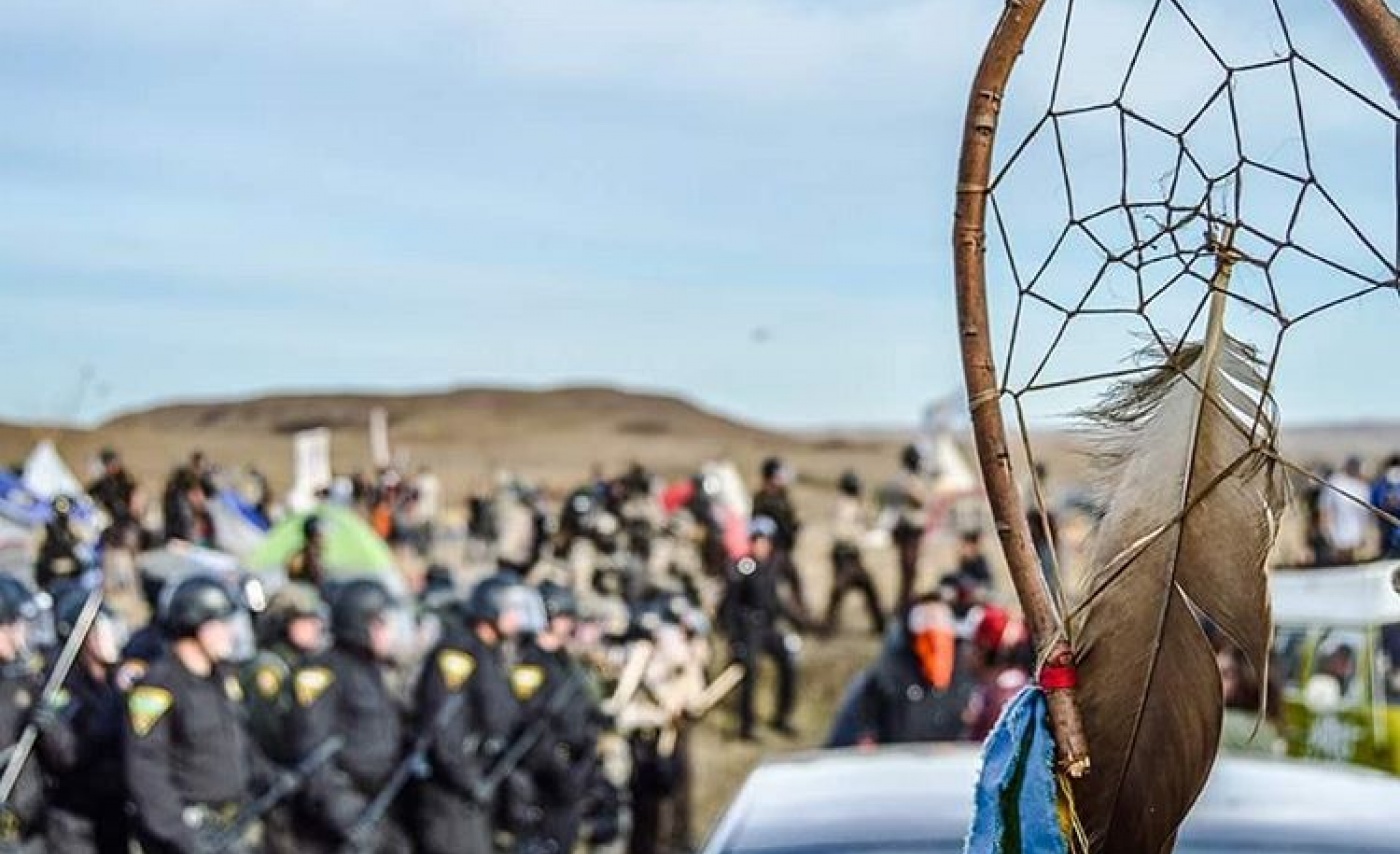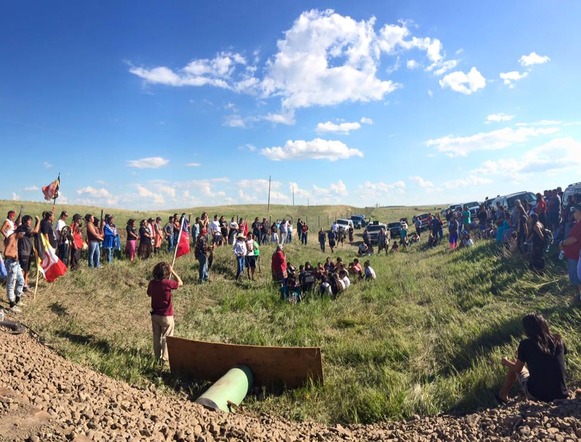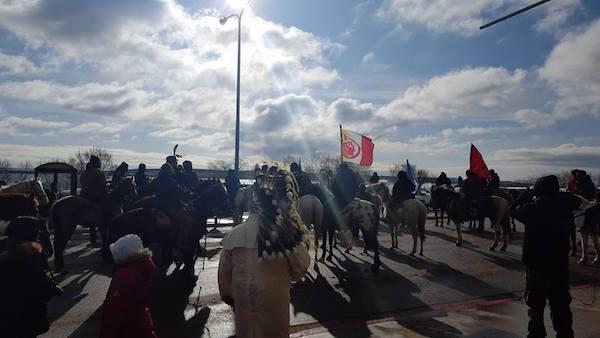
by Deep Green Resistance News Service | Nov 15, 2016 | Colonialism & Conquest
If treaties are the supreme law of the land, as the U.S. Constitution states, then how is it that treaties can be so easily broken by a government that claims to uphold a respect for the law? An even more unsettling question: how is it that the trail of broken treaties has been able to span generations under an outdated, imperial logic unknown to the majority of the U.S. citizens? The founding of the United States is predicated on this painful contradiction between principles of equality and rule of law on one side, and the colonial appropriation of land from native peoples who have inhabited them for millennia, on the other.
The current resistance against the construction of the Dakota Access Pipeline (DAPL) is inscribed in this contradiction, making evident the non-rule of law when it comes to appropriating native lands.
The history of Standing Rock is marked by the history of colonization predicated on the Doctrine of Discovery. The progressive erosion of its Sioux territory goes hand in hand with the logic of terra nullius, which framed land in the Americas as “empty” in order to justify settler colonization.
The Sioux Nation has historically engaged in sovereign government-to-government relations with the US government. The first treaty in which the two parties engaged as diplomatic equals was the Treaty of Fort Laramie of 1851. It was the U.S. government who sought the treaty to allow for safe passage of the influx of settlers travelling west through Sioux territory during the Gold Rush from the east coast to California.
The process of negotiating the Treaty of Fort Laramie followed the colonial settler standard used in contemporary treaty negotiations. While the process was equal in theory to the traditional communal decision-making processes under which many Native Nations operated, the colonial method, which uses elected representatives, heavily favored the interests of the colonial government. Ultimately, the treaty established distinct territories for just under 10 Great Plain tribes. The treaty also permitted settlers to travel on the Platte River Road, achieving the U.S. government’s goal.
The 1851 treaty defined Sioux territory as the land where the DAPL is now being constructed. The territory fell within the western half of modern South Dakota, northwest Nebraska, a portion of northeast Wyoming, and a small part of southeast Montana and southwest North Dakota.
From the very beginning, various parties continuously broke the Treaty of Fort Laramie. Many tribes, unaware of the existence of the treaty, continued to carry out raids on tribes on legally different territories. Furthermore, settlers increasingly trespassed into the treaty territories, disrupting the buffalo hunting grounds of Native Nations. The settlers’ wrongful presence on native land led to various hostile skirmishes and bloody battles in which natives were massacred often without provocation.
But the violation of the Treaty of Fort Laramie didn’t stop there. Over the years, the U.S. government has continued to appropriate Sioux land in an ongoing process of colonization that disregards the treaty. (See map.)
In 1861, the discovery of gold in present-day Montana accentuated the flood of fortune-seekers overrunning Sioux lands in violation of the decade-old Laramie Treaty. Sioux protests to defend their rights and territory were ignored, so the Sioux took matters into their own hands to stop the trespassers. The U.S. responded by sending in a military presence.
Instead of adhering to the terms of the treaty, the U.S. government attempted to negotiate another treaty more preferential to its interests. Treaty making, instead of a diplomatic engagement between two equally powerful sovereign nations had turned into a destructive means of grabbing land and resources from native people; a form of “conquest by law” as per the book by Lindsay G. Robertson.
The result was a second treaty of Fort Laramie signed in 1868. This new treaty shrank the territorial boundaries of the Great Sioux Reservation in exchange for the U.S. federal government’s removal of all existing forts in the Powder River area, among other specifications. Yet it was a flawed treaty from the start. Most importantly, it stipulates that no changes can be made to the legally binding agreement unless ¾ of all adult Sioux males consent. Many members of the Sioux nation, particularly those within the boundaries of the territory signed the treaty. But many more bands residing north of the Bozeman Trail, such as the Hunkpapa and Sihasapa bands, did not. The treaty was not signed by three quarters of all adult Sioux males.
Yet, again, the U.S. government violated the treaty. The second Laramie treaty granted the tribes the right of regulating the entry of persons into their territory. Article II of the 1868 Treaty stipulates that nobody can enter the territory without tribal permission. But time and time again settlers have encroached on Sioux territory.
Some Americans may know that in 1874 the U.S. government sent George Custer with a group of scientists to search for natural resources, especially gold, in the isolated mountain range known today as the Black Hills. The gold they found led to an influx of miners, again in direct violation of the treaty.
Eventually, the U.S. government decided to pursue its strategy of land appropriation without bothering with the pretense of legality. The Sioux learned to be wary of treaties with the U.S. and refused to sign away their land.
In 1877, Congress unilaterally passed an act removing the sacred Black Hills from the Great Sioux Reservation, without the ¾ consent of the Sioux mandated by the Laramie Treaty of 1868. This illegal grab of sacred land brought no legal repercussions to the party that violated the treaty—the U.S. government.
In 1889, Congress again diminished the Great Sioux Reservation with the Dawes Act and Allotment Act, partitioning it into six sections, one of which was the Standing Rock Sioux Reservation. This opened up parts of the reservation to outside settlement, even though the native government still controls all reservation lands.
Sioux struggles for water are embedded in such displacements. In 1948, the U.S. government began construction of Oahe Dam, despite resistance from local tribes. Its creation flooded tribal land and forced a quarter of the reservation’s inhabitants to move.
In 1958, a federal court ruled that Lake Oahe was part of the Standing Rock territory according to the 1868 Fort Laramie Treaty. In this ruling the court said, “Where there is a treaty with Indians which would otherwise restrict the Congress, Congress can abrogate the treaty in order to exercise its sovereign right.” The court openly articulated the self-arrogated right of the U.S. government to go back on treaty obligations with Native Americans to unilaterally exercise its sovereign power.
The U.S. did just that, taking the Lake Oahe land from the Standing Rock tribe through legislation passed by Congress in September 1958 [Public Law 85-915].
Legal abrogation, or repealing legislation, dispenses with any idea of fair treaty making between equals. It undermines native sovereignty, following a racist logic of colonial elimination. It dispenses with numerous prior legal precedents that granted Native Americans some rights, such as the Indian Appropriations Act of 1871, which declared that no treaty obligation with an Indian nation before March 3, 1871 can be “invalidated or impaired.” It puts into question the idea of the “federal Indian trust responsibility,” articulated in the Seminole Nation v. United States case of 1942, which entailed an obligation on the part of the U.S. government to protect tribal treaty rights, land, assets and resources, per the Department of the Interior Indian Affairs branch.
As a federally recognized tribe, the Standing Rock Sioux Tribe is legally entitled to these obligations. However, as history has shown, U.S. principles and laws do not seem to have the same meaning when it comes to Native Americans.
The United States claim that it can abrogate treaties with Native Americans has been upheld by US courts as legal. Law in our modern eyes carries the weight of legitimacy.
But because something is legal does not make it right. In the case of the Sioux, alongside every other Native American nation, laws and treaties have all too often been used not as a protective shield, or even as a neutral arbitrator, but as a weapon. That weapon is predicated on a racist, colonial history that invalidated native people’s rights to their land, to their sovereignty, to their cultural expression, to their very lives.
Whether it is the gold rush or the oil rush, the U.S government continues even now to invade native land and break treaties. The proposed DAPL would pass under Lake Oahe, the land that was openly, “legally” taken from the Sioux tribe in 1958 by Congress, despite the prior 1868 Treaty that had legally granted the Sioux rights to the land.
Today’s protests at Standing Rock today can only be fully understood in light of this colonial legacy, which from the beginning proclaimed that native lands were empty and that native people, were, in effect, nothing more than the rocks, the trees, the water that they now so valiantly strive to protect.
Let us fight against this narrative, and show through Standing Rock that native tribes are sovereign nations that possess the inherent right to life on their territories. Let us show that Native American lands are not empty, but that proud sovereign peoples live there, alongside the earth, water, rocks and trees, wind and sky, encompassing a vibrant fullness in their long defense of life.
There never was terra nullius. The only emptiness to be found exists in the hollow promises of the United States, in the historic lack of equitable substance in the U.S. legal system.
In that spirit, many U.S. citizens are now, finally, refusing to turn a blind eye to the trail of broken treaties. They stand with Standing Rock, and are petitioning President Obama to honor the treaties (petition here): “The Native nations have upheld their end of the bargain; it is time the U.S. government did the same.”

by Deep Green Resistance News Service | Nov 14, 2016 | Lobbying
by Cultural Survival
“We call upon all member states, to condemn the destruction of our sacred places and to support our nation’s efforts to ensure that our sovereign rights are respected. We ask that you call upon all parties to stop the construction of the Dakota Access pipeline and to protect the environment, our nation’s future, our culture and our way of life.”
– Standing Rock Sioux Tribe Chairman Dave Archambault II
The International Indigenous Peoples`Forum on Climate Change (IIPFCC) condemns the construction of the Dakota Access pipeline and stands in solidarity with our sisters and brothers of the Standing Rock Sioux Tribe and all Water Protectors in opposition to this project.
Human Rights and the Indigenous Rights Perspective
The Dakota Access pipeline is being built on the un-ceded treaty lands of the Standing Rock Sioux Tribe, without their free, prior and informed consent, as is described in the UN Declaration on the Rights of Indigenous Peoples in Articles 18, 19, and 32. The pipeline is also being constructed through sacred areas and ancestral burial grounds of the Standing Rock Sioux and other Indigenous Peoples of the area. This massive construction project does not respect the Standing Rock Sioux’s Treaty rights, sovereignty, or their right to self-determination. It is an outright violation of their rights over their lands and resources as Indigenous Peoples, and does not respect the human rights of Indigenous Peoples.
Climate Perspective
The Dakota Access pipeline will transport 470 000 – 570 000 barrels of oil every day, which will release emissions of 101,4 million tonnes CO2, as much as 30 American coal power plants, every year. This is not consistent with the State Parties’ obligations and commitments under the Paris Agreement or the Sustainable Development Goals (SDGs). The continued production of fossil fuels only assures that global temperature will rise well above 2°C in the immediate future and threaten the lives and livelihoods of Indigenous Peoples around the world. The potential for a major oil spill from the Dakota Access pipeline is immediate. The pipeline is scheduled to cross underneath the Missouri River, which is the main source for drinking water for the Standing Rock Sioux Reservation and for millions of people who live downstream. Sunoco Logistics, the operating company of the pipeline, alone has experienced over 200 oil spills in 6 years, and the US had in total over 3300 leaks since 2010, polluting rivers, ground waters, land and air, and both human lives, health and livelihoods has been lost.
The IIPFCC calls upon the US to halt the construction of the Dakota Access pipeline and to enter into serious consultations with the Standing Rock Sioux, and other tribes affected by this project, respecting the right of the Tribes to free, prior and informed consent.
The state owned Norwegian Oil Fund is heavily invested in the pipeline. The IIPFCC calls upon Norway to divest from the Dakota Access pipeline Project.
We also call on all States to ensure the protection of Indigenous Peoples´ territories across the world as a critical action in the implementation of the Paris Agreement and in achieving the SDGs.
Featured image by A. Golden/Flickr.

by Deep Green Resistance News Service | Aug 22, 2016 | Lobbying
Featured image: Dakota Access Pipeline Protest In North Dakota. Photo Credit: “No Dakota Access in Treaty Territory – Camp of the Sacred Stones”
By International lndian Treaty Council
Ft. Yates, North Dakota, United States: On Thursday, August 18, 2016 the Standing Rock Sioux Tribe and the International Indian Treaty Council (IITC) jointly submitted an urgent action communication to four United Nations (UN) human rights Special Rapporteurs. It cited grave human rights and Treaty violations resulting from the construction of the Dakota Access crude oil pipeline in close proximity to the Standing Rock Reservation by the United States Army Corps of Engineers and Dakota Access LLC, a subsidiary of Texas-based Energy Transfer.
The Standing Rock Sioux Tribe (SRST) stands in firm opposition to the Dakota Access Pipeline. The pipeline would carry nearly half a billion barrels of crude oil a day, and would cross the Missouri River threatening the Tribe’s main water source and sacred places along its path including burials sites. The urgent communication was submitted to UN Special Rapporteurs on the situation of human rights defenders; the Rights of Indigenous Peoples; the human right to safe drinking water and sanitation; and Environment and Human Rights, as well as the Office of the UN High Commissioner for Human Rights. It requests that they urge the United States to halt the human rights violations and uphold its human rights and Treaty obligations to the Standing Rock Tribe. It was also forwarded to key officials in the U.S. State Department, Department of Interior and the White House.
The urgent communication focuses on violations of the UN Declaration on the Rights of Indigenous Peoples, the 1868 Ft. Laramie Treaty and other International human rights standards to which the United States is obligated. It also cites actions against human rights defenders, including arrests and other forms of intimidation, violations of the human right to water, and lack of redress and response using domestic remedies. The submission noted that this action violates Article 32 of the UN Declaration on the Rights of Indigenous Peoples, which affirms the obligation of States to obtain Indigenous Peoples’ free prior and informed consent before development projects affecting their lands, territories or other resources are carried out. The Lakota and Dakota, which includes the SRST, were part of the Sovereign Sioux Nation, which concluded the 1868 Ft. Laramie Treaty with the United States. The United States has legally-binding obligations based on this Treaty to obtain the Lakota and Dakota’s consent before activities are carried out on their Treaty lands.
The urgent communication also highlights environmental racism in violation of the International Convention on the Elimination of all Forms of Racial Discrimination Convention (ICERD) to which the US is legally obligated. It notes that the United States has permitted Energy Transfer to divert the pipeline’s route from near the mainly non-Indigenous population of Bismarck, ND to disproportionately impact the SRST.
A primary concern expressed by the Tribe is potential devastating effects on its primary water source. SRST Chairman Dave Archambault II, who was among those arrested and is also being sued by the company for obstructing the pipeline’s construction, stated on August 15th “I am here to advise anyone that will listen, that the Dakota Access Pipeline is harmful. It will not be just harmful to my people but its intent and construction will harm the water in the Missouri River, which is the only clean and safe river tributary left in the United States.”
In response to the Tribe’s opposition, Dakota Access LLC, the developers of the $3.8 billion, four-state oil pipeline, has waged a concerted campaign to criminalize and intimidate Tribal leaders, Tribal members and their supporters who have consistently been peaceful and non-violent. The IITC and SRST are calling upon the UN Rapporteur on Human Rights Defenders to call upon the United States to immediately cease all arrests and other forms of intimidation, drop any pending lawsuits, and ensure that all legal charges against these human and Treaty Rights defenders be lifted. The urgent action communication cited this case as an example of the criminalization of Indigenous human rights defenders around the world, as noted by various UN bodies.
Despite 28 arrests reported to date, the peaceful protesters have succeeded in temporarily halting the pipeline’s construction. A hearing is currently scheduled for next week in federal court to consider the Tribe’s request for an injunction. Construction has reportedly been halted until the hearing, providing an important initial victory for the Tribe and their supporters.
The joint urgent UN communication requests the intervention of these UN human rights mandate holders to call upon the United States to uphold its statutory, legal, Treaty and human rights obligations and impose an immediate and ongoing moratorium on all pipeline construction until the Treaty and human rights of the Standing Rock Sioux Tribe, including their right to free prior and informed consent, can be ensured.
Editor’s note: for more current news on the Dakota Access Pipeline, see U.S. Government Bans Native American Tribe From Protesting On Their Own Land – Send In Police To Remove Protesters and Dalrymple signs emergency declaration to manage public safety at Dakota Access Pipeline protest near Cannon Ball

by DGR News Service | Jun 17, 2014 | Indigenous Autonomy, Mining & Drilling
Deep Green Resistance is dedicated to the fight against industrial civilization and its legacy of racism, patriarchy, and colonialism. For this reason, DGR would like to publicly state its support for the Oglala Lakota in their current fight against the genocidal mining operations of the Cameco Corporation.
Cameco is currently attempting to expand its already illegal resource extraction campaign despite undeniable evidence that their abuse of the Earth is leading to increased rates of cancer, diabetes, and other life-threatening illnesses among the Lakota people.
The only acceptable action on the part of the Cameco Corporation is immediate cessation of any and all mining activities in the ancestral home of the Lakota people; anything else will be met with resistance, and DGR will lend whatever support it can to those on the front lines.
The indigenous peoples of this land have always been at the forefront of the struggle against the dominant culture’s ecocidal violence, and DGR would like to offer its support and encouragement to Debra White Plume, the Lakota activist group Owe Aku, and all other indigenous women and men fighting for the future of the planet. The time for resistance is long past, and we are thankful every day that the Earth has warriors like the Oglala Lakota fighting in its defense.
For more information, please visit Owe Aku International at http://oweakuinternational.org/





